- GB 1 (Tóng Zĭ Liáo, 瞳子髎)
- GB 2 (Tīng Huì, 听会)
- GB 3 (Shàng Guān, 上关)
- GB 4 (Hán Yàn, 颔厌)
- GB 5 (Xuán Lú, 悬颅)
- GB 6 (Xuán Lí, 悬厘)
- GB 7 (Qū Bìn, 曲鬓)
- GB 8 (Shuài Gŭ, 率谷)
- GB 9 (Tiān Chōng, 天冲)
- GB 10 (Fú Bái, 浮白)
- GB 11 (Tóu Qiào Yīn, 头窍阴)
- GB 12 (Wán Gŭ, 完骨)
- GB 13 (Bĕn Shén, 本神)
- GB 14 (Yáng Bái, 阳白)
- GB 15 (Tóu Lín Qì, 头临泣)
- GB 16 (Mù Chuāng, 目窗)
- GB 17 (Zhèng Yíng, 正营)
- GB 18 (Chéng Líng, 承灵)
- GB 19 (Năo Kōng, 脑空)
- GB 20 (Fēng Chí, 风池)
- GB 21 (Jiān Jĭng, 肩井)
- GB 22 (Yuān Yè, 渊腋)
- GB 23 (Zhé Jīn, 辄筋)
- GB 24 (Rì Yuè, 日月)
- GB 25 (Jīng Mén, 京门)
- GB 26 (Dài Mài, 带脉)
- GB 27 (Wŭ Shū, 五枢)
- GB 28 (Wéi Dào, 维道)
- GB 29 (Jū Liáo, 居髎)
- GB 30 (Huán Tiào, 环跳)
- GB 31 (Fēng Shì, 风市)
- GB 32 (Zhōng Dú, 中渎)
- GB 33 (Xī Yáng Guān, 膝阳关)
- GB 34 (Yáng Líng Quán, 阳陵泉)
- GB 35 (Yáng Jiāo, 阳交)
- GB 36 (Wài Qiū, 外丘)
- GB 37 (Guāng Míng, 光明)
- GB 38 (Yáng Fǔ, 阳辅)
- GB 39 (Xuán Zhōng, 悬钟)
- GB 40 (Qiū Xū, 丘墟)
- GB 41 (Zú Lín Qì, 足临泣)
- GB 42 (Dì Wǔ Huì, 地五会)
- GB 43 (Xiá Xī, 侠溪)
- GB 44 (Zú Qiào Yīn, 足窍阴)
There are 44 bilateral points on the gallbladder channel: 20 on the head and face; 3 on the chest and hypochondrium; 6 on the posterior aspect of the waist; 15 on the lateral aspect of the lower limbs. The first is lateral to the outer canthus of the eye, GB 1 (tóng zĭ liáo); the last, on the fourth toe lateral to the distal pharynx, GB 44 (zú qiào yīn). The indications for this channel and its points include head, nose, eye, throat, mental, and febrile diseases and disorders of the running course.
GB 1 (Tóng Zĭ Liáo, 瞳子髎)
Intersecting point of the hand taiyang and hand and foot shaoyang channels
Location. On the head in the depression 0.5 cun lateral to the outer canthus of the eye (Pic. 3-73)
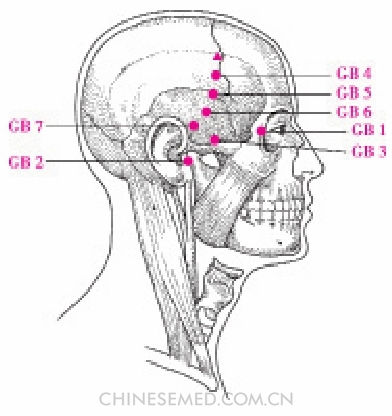
Actions. Scatter and dissipate wind heat, and remove nebula to improve vision.
Indications. Headache, dizziness, deviation of mouth and eye, eye pain, eye nebula, tearing due to wind exposure, excessive eye discharge; other head, face, and eye disorders.
Manipulation. Acupuncture: 1. Needle obliquely toward the back 0.5~0.8 cun. Local soreness and distention might radiate to the external auditory canal. 2. Insert toward tài yáng (EX-HN 5). Local soreness and distention might radiate to the external auditory canal. 3. Bleed using a three-edged needle. Moxibustion: Use a moxa stick for 5~10 minutes.
Annotation. The point appeared in The Systematic Classic of Acupuncture and Moxibustion (ZhēnJiŭ Jiă Yĭ Jīng, 针灸甲乙经). Liáo means bone crevice. The point is in a crevice lateral to the pupil of the eye, so is called tóng zĭ liáo, pupil crevice.
GB 2 (Tīng Huì, 听会)
Location. On the face in the depression between the intertragic notch and the condyloid process (Pic. 3-73).
Location.method. With the patient’s mouth open, the point is in the depression anterior to the intertragic notch, directly below SI 19 (tīng gōng).
Actions. Open the orifices and improve hearing, quicken collaterals, and calm the mind.
Indications. Tinnitus, deafiness, and otopyorrhea; toothache, deviation of mouth and eye.
Manipulation. Acupuncture: Needle perpendicularly 0.5~1.0 cun. Local soreness and distention can be felt. Moxibustion: Use 3~5 cones of cone moxibustion, or use warming needle moxibustion for 20 minutes, or use a moxa stick for 10~20 minutes.
Annotation. The point appeared in The Systematic Classic of Acupuncture and Moxibustion (ZhēnJiŭ Jiă Yĭ Jīng, 针灸甲乙经). Tīng means hearing; huì means converge. Needling this point can improve hearing by causing the vibrations made by sound waves to converge; thus it is named tīnghuì, meet hearing.
GB 3 (Shàng Guān, 上关)
Intersecting point of hand shaoyang, foot shaoyang, and foot yangming channels
Location. On the head in the depression superior to the midpoint of the zygomatic arch (Pic. 3-73).
Location.method. The point is in the depression above the zygomatic arch, superior to ST 7 (xiàguān).
Actions. Improve hearing and open the orifices, dissipate wind and quicken collaterals.
Indications. Facial pain, deviation of mouth and eye, locked jaw, other face and mouth disorders; tinnitus, deafiness, otopyorrhea, eye pain, eye nebula, tearing due to wind exposure, excessive eye discharge, other disorders of ear and eye.
Manipulation. Acupuncture: Needle perpendicularly 0.5~0.8 cun. Local soreness and distention can be felt. Moxibustion: Use 3~5 cones of cone moxibustion, or use a moxa stick for 10~15 minutes. Medicinal or natural moxibustion may also be used.
Annotation. The point appeared in The Spiritual Pivot-Fundamental Points (Líng Shū-Běn Shū,灵枢·本输). Shàng means above; guān means joint. The point is above ST 7 (xià guān) on the joint and so is called shàng guān, above the joint.
GB 4 (Hán Yàn, 颔厌)
Intersecting point of the hand shaoyang, foot shaoyang, and foot yangming channels
Location. On the head at the junction of the upper 1/4 and lower 3/4 of the curved line from ST 8 (tóu wéi) to GB 7 (qū bìn) (Pic. 3-73).
Location.method. Draw an arc from ST 8 protruding anteriorly towards GB 7. The midpoint of the arc is GB 5 (xuán lú); GB 4 is at the upper fourth of the arc above GB 5. Ask the patient to perform a chewing action; it will cause a slight movement at the area.
Actions. Improve hearing and open the orifices, dissipate wind and quicken collaterals.
Indications. Headache, dizziness, deviation of mouth and eye, other head and face disorders; epilepsy from fright; convulsion; tinnitus, deafiness, otopyorrhea, eye pain, eye nebula, tearing on exposure to wind, outer canthus pain, toothache, other fve sensory organ disorders.
Manipulation. Acupuncture: Needle transversely 0.3~0.5 cun. Local soreness and distention can be felt. Moxibustion: Use 3~5 cones of indirect moxibustion, or use a moxa stick for 5~10 minutes.
Annotation. The point appeared in The Systematic Classic of Acupuncture and Moxibustion (Zhēn Jiŭ Jiă Yĭ Jīng, 针灸甲乙经); it is named for its location and function. Hán refers to cheek; yàn means corresponding. When a person chews, the cheek and temporal regions move together at the region of the point. Hán also means nodding, and yàn can mean inhibition. This point can treat shaking and nodding of the head due to rising liver yang. Its name, hán yàn, signifies mandible obedience.
GB 5 (Xuán Lú, 悬颅)
Intersecting point of the hand and foot shaoyang and yangming channels
Location. On the head at the midpoint of the curved line from ST 8 (tóu wéi) to GB 7 (qū bìn) (Pic. 3-73).
Actions. Unblock channels and quicken collaterals, clear heat and dissipate wind.
Indications. Migraine, swelling of face, outer canthus pain, other head and face disorders.
Manipulation. Acupuncture: Needle transversely 0.5~0.8 cun. Local soreness and distention can be felt. Moxibustion: Use 3~5 cones of indirect moxibustion, or use a moxa stick for 5~10 minutes.
Precaution. Direct moxibustion is prohibited.
Annotation. The point appeared in Spiritual Pivot-Cold and Febrile Diseases (Líng Shū-HánRè Bìng, 灵枢·寒热病). Xuán means suspend; lú means skull. This point is between the corner of the head and posterior ear as if suspended from the corner of the head. Thus it was named xuán lú, suspended skull.
GB 6 (Xuán Lí, 悬厘)
Intersecting point of hand and foot shaoyang and yangming channels
Location. On the head at the junction of the upper 3/4 and lower 1/4 of the curved line from ST 8 (tóu wéi) to GB 7 (qū bìn) (Pic. 3-73).
Location.method. The point is superior to the temple at the midpoint between GB 5 (xuán lú) and GB 7 (qū bìn).
Actions. Unblock channels and quicken collaterals, clear heat and dissipate wind.
Indications. Headache and dizziness, tinnitus, deafiness, otopyorrhea, eye pain, eye nebula, tearing due to wind exposure, outer canthus pain, other ear and eye disorders.
Manipulation. Acupuncture: Needle transversely 0.5~0.8 cun. Local soreness and distention can be felt. Moxibustion: Use 3~5 cones of indirect moxibustion, or use a moxa stick for 5~10 minutes.
Annotation. The point appeared in The Systematic Classic of Acupuncture and Moxibustion (ZhēnJiŭ Jiă Yĭ Jīng, 针灸甲乙经). Lí means a short distance. This point is a short distance below GB 5 (xuán lú). Thus it is called xuán lí, hanging short distance.
GB 7 (Qū Bìn, 曲鬓)
Intersecting point of the foot shaoyang and foot taiyang channels
Location. On the head at the junction of a vertical line on the posterior border of the temple hairline and a horizontal line at the apex of the auricle (Pic. 3-73).
Actions. Clear heat, dissipate wind, quicken collaterals, and relieve stuffy orifices.
Indications. Headache with toothache, swelling of cheek, locked jaw, other head and face disorders.
Manipulation. Acupuncture: Needle transversely 0.5~0.8 cun. Local soreness and distention can be felt. Moxibustion: Use 3~5 cones of indirect moxibustion, or use a moxa stick for 5~10 minutes.
Annotation. The point appeared in The Systematic Classic of Acupuncture and Moxibustion (ZhēnJiŭ Jiă Yĭ Jīng, 针灸甲乙经). Qū means winding; bìn refers to the temple. This point is anterior and superior to the ear near the place the hairline bends posteriorly, so it is called qū bìn, winding temple.
GB 8 (Shuài Gŭ, 率谷)
Intersecting point of the foot shaoyang and foot taiyang channels
Location. On the head directly above the auricular apex, 1.5 cun superior to the temporal hairline (Pic. 3-74).
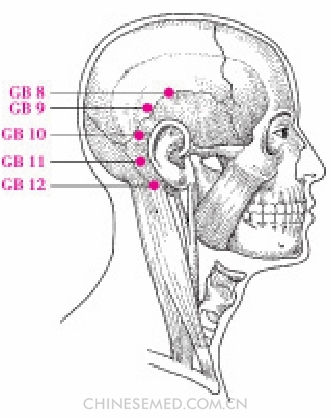
Location.method. The point is superior to SJ 20 (jiăosūn), 1.5 cun within the hairline. It is easier to palpate the point when the subject is chewing.
Actions. Clear heat and extinguish wind, unblock channels and quicken collaterals.
Indications. Headache, dizziness, infantile convulsion.
Manipulation. Acupuncture: Needle transversely 0.5~0.8 cun. Local soreness and distention can spread to the temporal region. Moxibustion: Use 3~5 cones of indirect moxibustion, or use a moxa stick for 5~10 minutes.
Annotation. The point appeared in The SystematicClassic of Acupuncture and Moxibustion (Zhēn Jiŭ Jiă YĭJīng, 针灸甲乙经). This point corresponds to the depression at the juncture of the parietal, temporal, and sphenoid bones. Shuài means along; gŭ means valley between two hills. The name of the point means shuài gŭ, along the valley.
GB 9 (Tiān Chōng, 天冲)
Intersecting point of foot shaoyang and foot taiyang channels
Location. On the head directly superior to the posterior border of the auricular root, 2 cun above the hairline (Pic. 3-74).
Location.method. The point is located 0.5 cun posterior to GB 8 (shuài gŭ).
Actions. Dispel wind and suppress fright, clear heat and dissipate masses.
Indications. Headache, dizziness, epilepsy, swollen and painful gums.
Manipulation. Acupuncture: Needle transversely 0.5~1.0 cun. Local soreness and distention can be felt. Moxibustion: Use 3~5 cones of indirect moxibustion, or use a moxa stick for 5~10 minutes.
Annotation. The point appeared in The Systematic Classic of Acupuncture and Moxibustion (ZhēnJiŭ Jiă Yĭ Jīng, 针灸甲乙经). Tiān refers to the head. Chōng means straight through or uninhibited passage. The name of the point is tiān chōng, heavenly gushing.
GB 10 (Fú Bái, 浮白)
Intersecting point of the foot shaoyang and foot taiyang channels
Location. On the head posterosuperior to the mastoid process at the junction of the upper 1/3 and lower 2/3 of a curved line from GB 9 (tiān chōng) to GB 12 (wán gŭ) (Pic. 3-74).
Actions. Clear the head, dissipate wind, rectify qi, and dissipate masses.
Indications. Headache, toothache, tinnitus and deafiness, qi goiter.
Manipulation. Acupuncture: Needle transversely 0.5~0.8 cun. Local soreness and distention can be felt. Moxibustion: Use 3~5 cones of indirect moxibustion, or use a moxa stick for 5~10 minutes.
Annotation. The point appeared in Basic Questions-Treatise on Acupoints (Sù Wèn-Qì XuéLùn, 素问·气穴论). Fú means a high location; bái means easily noticeable. This point is on a high spot above the mastoid process, thus easily noticeable. Fú can also mean foating, and bái, white, is the color corresponding to the lung. This point can dispel phlegm, relieve panting, and treat lung disorders, giving further meaning to its name, fú bái, foating white.
GB 11 (Tóu Qiào Yīn, 头窍阴)
Intersecting point of the hand and foot taiyang and shaoyang channels
Location. On the head posterior and superior to the mastoid process at the junction of the upper 2/3 and lower 1/3 of a curved line from GB 9 (tiān chōng) to GB 12 (wán gŭ) (Pic. 3-74).
Actions. Rectify qi and suppress pain, open the orifices and improve hearing.
Indications. Headache, dizziness, neck rigidity, tinnitus, deafiness.
Manipulation. Acupuncture: Needle transversely 0.5~0.8 cun. Local soreness and distention can spread to the posterolateral side of the head. Moxibustion: Use 3~5 cones of indirect moxibustion, or use a moxa stick for 5~10 minutes.
Annotation. The point appeared in The Systematic Classic of Acupuncture and Moxibustion (ZhēnJiŭ Jiă Yĭ Jīng, 针灸甲乙经). It was originally known as qiào yīn for its connection to GB 44 (zúqiào yīn) on the foot. Comprehensive Recording of Divine Assistance from the Zhenghe Era (ZhèngHé Shèng Jì Zŏng Lù, 政和圣济总录) called this point shŏu qiào yīn, while Classic of NourishingLife with Acupuncture and Moxibustion (Zhēn Jiŭ Zī Shēng Jīng, 针灸资生经) called it tóu qiàoyīn. Qiào refers to the fve sensory organs and seven orifices. The fve zang organs open to the fve sensory organs, and this point treats sensory disorders. As zang organs belong to yin and the point is on the head, its name is now tóu qiào yīn, yin portal of the head.
GB 12 (Wán Gŭ, 完骨)
Intersecting point of foot shaoyang and taiyang channels
Location. On the anterior region of the neck in the depression posteroinferior to the mastoid process (Pic. 3-74).
Actions. Unblock channels, quicken collaterals, dispel wind, and clear heat.
Indications. Headache, dizziness, deviation of mouth and eye, tinnitus, deafiness, eye pain, toothache; epilepsy.
Manipulation. Acupuncture: Needle obliquely 0.5~0.8 cun. Local soreness and distention can spread to the top of the head. Moxibustion: Use 3~5 cones of indirect moxibustion, or use warming needle moxibustion for 20 minutes, or use a moxa stick for 5~10 minutes.
Annotation. The point appeared in Basic Questions-Treatise on Acupoints (Sù Wèn-Qì Xué Lùn,素问·气穴论). Wán gŭ refers to the mastoid process posterior to the ear. The point is posterior and inferior to the mastoid process, giving it the name wán gŭ, mastoid process.
Modern clinical observation and research. In a case study on bloodletting GB 12 (wán gŭ) for occipital neuralgia, GB 12 and obvious tender spots in its surrounding area were pricked with a three-edged needle once a day. Courses were seven days with three days in between. Of 12 cases, 9 recovered, 2 benefited significantly, and 1 benifted somewhat.1
1 Chen Y, Yang ST. Twelve cases of occipital neuralgia treated with bloodletting at GB 12 (wán gŭ) as the main therapy完骨穴放血为主治疗枕神经痛12例. Journal of Clinical Acupuncture and Moxibustion. 2004; 20(4): 40.
GB 13 (Bĕn Shén, 本神)
Intersecting point of the foot shaoyang channel and yangwei mai
Location. On the head 0.5 cun superior to the anterior hairline, 3 cun lateral to the anterior median line (Pic. 3-75).
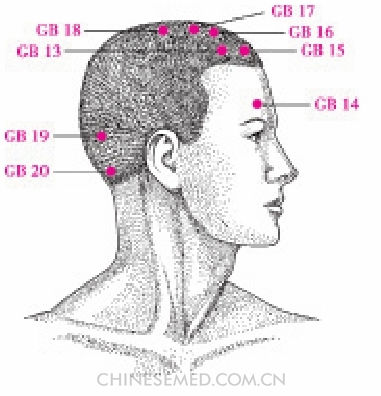
Location.method. The point is at the junction of the medial 2/3 and lateral 1/3 of a curved line from DU 24 (shén tíng) to ST 8 (tóu wéi).
Actions. Dispel wind, suppress fright, clear heat, and relieve pain.
Indications. Stroke with unconsciousness, epilepsy, infantile fright and fainting; headache, dizziness, neck rigidity.
Manipulation. Acupuncture: Needle transversely 0.5~0.8 cun. Local soreness and distention can be felt at the local area. Moxibustion: Use 3~5 cones of indirect moxibustion, or use a moxa stick for 5~10 minutes.
Precaution. Direct moxibustion is forbidden.
Annotation. The point appeared in The Systematic Classic of Acupuncture and Moxibustion (Zhēn Jiŭ Jiă Yĭ Jīng, 针灸甲乙经). Bĕn means root; shén means spirit. The point is lateral to DU 24 (shén tíng) on the head, which houses the original spirit, and is important in the treatment of mental disorders; hence the name, bĕn shén, root of the spirit.
GB 14 (Yáng Bái, 阳白)
Intersecting point of the hand and foot yangming, shaoyang channels and yangwei mai
Location. On the head 1 cun above the eyebrow, directly superior to the center of the pupil (Pic. 3-75).
Actions. Clear the head and improve vision, dispel wind and discharge heat.
Indications. Forehead pain; incomplete closure of eyelid, twitching of eyelid, eye pain.
Manipulation. Acupuncture: Needle transversely 0.5~0.8 cun. Local soreness and distention can be felt. Moxibustion: Use 3~5 cones of indirect moxibustion, or use a moxa stick for 5~10 minutes.
Annotation. The point appeared in The Systematic Classic of Acupuncture and Moxibustion (ZhēnJiŭ Jiă Yĭ Jīng, 针灸甲乙经). Yáng refers to the forehead; bái means clear in this context. This point is on the forehead, treats eye disorders, and improves vision; hence the name yáng bái.
GB 15 (Tóu Lín Qì, 头临泣)
Intersecting point of the foot shaoyang and taiyang channels and the yangwei mai
Location. On the head 0.5 cun within the anterior hairline, directly superior to the center of the pupil (Pic. 3-75).
Location.method. With the eyes looking straight ahead, the point is above the center of the pupil at the midpoint of the curved line from DU 24 (shén tíng) to ST 8 (tóu wéi).
Actions. Clear the head, improve vision, and calm the mind.
Indications. Headache, dizziness, swollen and painful red eyes, night blindness, double vision, eye nebula, excessive eye discharge, tearing, tinnitus, deafiness, nasal obstruction, sinusitis; infantile convulsion, sudden stroke resulting in unconsciousness.
Manipulation. Acupuncture: Needle transversely 0.5~0.8 cun. Local soreness and distention can be felt. Moxibustion: Use 3~5 cones of indirect moxibustion, or use a moxa stick for 5~10 minutes.
Precautions. Direct moxibustion is forbidden.
Annotation. The point appeared in The Systematic Classic of Acupuncture and Moxibustion (ZhēnJiŭ Jiă Yĭ Jīng, 针灸甲乙经). The eye is where tears occur; the point, above the eye and effective in eye disorders, is called tóu lín qì, head governor of tears.
GB 16 (Mù Chuāng, 目窗)
Intersecting point of the foot shaoyang channel and yangwei mai
Location. On the head 1.5 cun within the anterior hairline, directly superior to the center of the pupil (Pic. 3-75).
Actions. Clear the head, improve vision, and disperse wind-heat.
Indications. Headache, dizziness, face and eye swelling, optic atrophy, eye nebula; infantile convulsion.
Manipulation. Acupuncture: Needle transversely 0.5~0.8 cun. Local soreness and distention can be felt. Moxibustion: Use 3~5 cones of indirect moxibustion, or use a moxa stick for 5~10 minutes.
Precaution. Direct moxibustion is forbidden.
Annotation. The point appeared in The Systematic Classic of Acupuncture and Moxibustion (ZhēnJiŭ Jiă Yĭ Jīng, 针灸甲乙经) and treats eye disorders. Mù refers to the location directly above the pupil in the temporal region. Chuāng means window to heaven. The point directly associates with the eye, so it was named mù chuāng, window of the eye.
GB 17 (Zhèng Yíng, 正营)
Intersecting point of the foot shaoyang channel and yangwei mai
Location. On the head 2.5 cun within the anterior hairline, directly superior to the center of the pupil (Pic. 3-75).
Actions. Clear the head and improve vision, scatter wind, and relieve pain.
Indications. Headache, dizziness, face and eye swelling, swollen and painful red eyes.
Manipulation. Acupuncture: Needle transversely 0.5~0.8 cun. Local soreness and distention will be felt. Moxibustion: Use 3~5 cones of indirect moxibustion, or use a moxa stick for 5~10 minutes.
Annotation. The point appeared in The Systematic Classic of Acupuncture and Moxibustion (ZhēnJiŭ Jiă Yĭ Jīng, 针灸甲乙经). Zhèng means middle; yíng means gather. This point is on the head where the corporeal soul resides, at the middle of fve foot shaoyang channel points on the head. It is also where the channel qi of the foot shaoyang and yangwei mai gathers, so it was named zhèng yíng, middle gathering.
GB 18 (Chéng Líng, 承灵)
Intersecting point of the foot shaoyang and yangwei channels
Location. On the head 4 cun within the anterior hairline, directly superior to the center of the pupil (Pic. 3-75).
Location.method. The point is 1.5 cun posterior to GB 17 (zhèng yíng) at the level of BL 7 (tōngtiān).
Actions. Clear the head and improve vision, and dissipate wind-heat.
Indications. Headache, dizziness, nasal obstruction, eye diseases, nasosinusitis, epistaxis.
Manipulation. Acupuncture: Needle transversely 0.5~0.8 cun to produce local soreness and distention. Moxibustion: Use 3~5 cones of indirect moxibustion, or use a moxa stick for 5~10 minutes.
Annotation. The point appeared in The Systematic Classic of Acupuncture and Moxibustion (Zhēn Jiŭ Jiă Yĭ Jīng, 针灸甲乙经). Chéng means support; líng can mean spirit or parietal bone. The point, 1.5 cun posterior to GB 17 (zhèng yíng) on the parietal region, is analogous to a support for the spirit, so was named chéng líng, support spirit.
GB 19 (Năo Kōng, 脑空)
Intersecting point of foot shaoyang channel and yangwei mai
Location. On the head at the level of the superior border of the external occipital protuberance, directly superior to GB 20 (fēng chí) (Pic. 3-75).
Actions. Awaken mind, relieve stuffy orifices, quicken collaterals, and dissipate wind.
Indications. Headache, neck rigidity, dizziness, swollen and painful red eyes, nasal pain, deafiness; epilepsy; palpitations due to fright.
Manipulation. Acupuncture: Needle transversely 0.5~0.8 cun. Local soreness and distention can spread to the back of the head. Moxibustion: Use 3~5 cones of indirect moxibustion, or use a moxa stick for 5~10 minutes.
Annotation. The point appeared in The Systematic Classic of Acupuncture and Moxibustion (ZhēnJiŭ Jiă Yĭ Jīng, 针灸甲乙经). Năo means brain; kōng means hollow. The point, 1.5 cun posterior to GB 18 (chéng ling) in the depression inferiolateral to the occipital bone and lateral to DU 17 (năo hù), corresponds to the brain. Its chief indication is brain disorders, so it is called năo kōng, brain hollow.
GB 20 (Fēng Chí, 风池)
Intersecting point of the foot shaoyang and the yangwei channel
Location. At the anterior region of the neck inferior to the occipital bone in the depression between the origins of sternocleidomastoid and trapezius muscles (Pic. 3-75).
Actions. Clear the head and improve vision, dispel wind, resolve toxins, and relieve stuffy orifices.
Indications. Externally-contracted diseases such as headache, fever, cold chills, febrile disease with no perspiration, neck pain, and neck rigidity; headache, dizziness, swollen and painful red eyes, tearing on exposure to wind, eye nebula, blurred vision, sparrow vision, optic atrophy, swollen face, deviated mouth, sinusitis, nosebleed, tinnitus, deafiness; insomnia, epilepsy, stroke, qi syncope syndrome.
Manipulation. Acupuncture: 1. Needle obliquely 0.5~1.5 cun toward the contralateral or ipsilateral corner of the mouth. Local soreness and distention can spread to the top of the head, temporal region, forehead, and eye. 2. Needle transversely 2.0~3.0 cun to penetrate GB 20 on the other side. Local soreness and distention can spread to the top of the head. 3. Needle downward 1.0~1.5 cun toward the nasal tip at the level of the ear lobule. The chief indications for this technique are headache and dizziness. 4. Needle 0.6~1.2 cun toward the contralateral inferiomedial side of the orbit of the eye. The chief indication for this technique is cervical hyperplasia. Moxibustion: Use warming needle moxibustion for 20 minutes, or use a moxa stick for 10~20 minutes.
Precaution. Pay attention to the direction and depth when needling GB 20. If inserted too deeply toward the contralateral outer canthus, the needle can injure the vertebral artery and even enter the cranial cavity to damage the medulla. The vertebral artery and medulla can also be injured if the needle is angled medially and inserted too deeply toward the nasal tip at the level of the ear lobule.
Annotation. The point appeared in The Spiritual Pivot-Febrile Diseases (Líng Shū-Rè Bìng, 灵枢·热病). Fēng means wind; chí means pool. This point is in a pool-like depression and is effective in disorders caused by wind, so it was named fēng chí, wind pool.
Modern clinical observation and research. In an RCT on syndrome differentiation in primary hypertension (n=135), two groups were treated at GB 20, LI 11, ST 36, and SP 6 once a day; in the observation group (n=108), supplementary points were added according to syndrome differentiation. After 15 days, effective rates were 84.2% in the observation group, 70.4% in control (P<0.05). The acupuncture was significantly effective in primary hypertension, and syndrome differentiation improved the efficacy.1
GB 21 (Jiān Jĭng, 肩井)
Intersecting point of hand and foot shaoyang, foot yangmingchannels and yangwei mai
Location. On the posterior neck at the midpoint of a line connecting the spinous process of the seventh cervical vertebra (C7) to the lateral end of the acromion (Pic. 3-76).
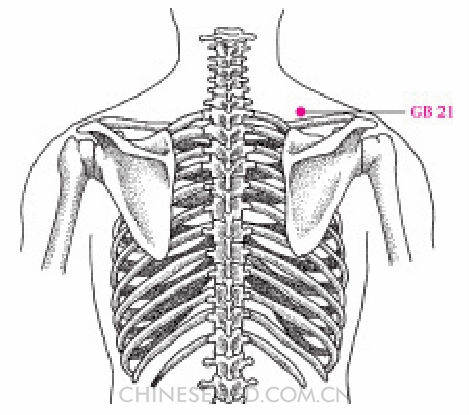
Location.method. Put your transverse wrist crease at the lower border of the scapular spine, thumb below the 7th cervical vertebra and the other four fingers adducted and placed on the shoulder. The index fnger lies on the neck and the middle fnger is bent slightly. The point is at the tip of the middle fnger.
Actions. Direct counterflowing qi downward and rectify qi, dissipate masses, supplement deficiency, unblock channels, and quicken collaterals.
Indications. Neck rigidity, shoulder and arm pain, inability to raise the arm; difficult labor, fooding and spotting, retention of placenta, inhibited lactation after birth; scrofula.
Manipulation. Acupuncture: Needle 0.5~0.8 cun. Local soreness and distention can spread to the shoulder region. Moxibustion: Use 3~5 cones of cone moxibustion, or use a moxa stick for 10~20 minutes.
Precautions. It is important to control needling direction and depth. Do not insert the needle obliquely toward the medial side or deeply when needling perpendicularly to prevent causing pneumothorax.
Annotation. The point appeared in The Systematic Classic of Acupuncture and Moxibustion (ZhēnJiŭ Jiă Yĭ Jīng, 针灸甲乙经). Jiān means shoulder; jĭng means well. The point is in the depression on the shoulder, which is deep like a well, so it was named jiān jĭng, shoulder well.
Modern clinical observation and research. In a study on acupuncture cholecystitis, 200 patients were compared to 100 healthy individuals. Both groups were needled on the right GB 21; gallbladder volume was compared before needling, 15 minutes after insertion, and 30 minutes after withdrawal. In the treatment group, the improvement were statistically significant (P<0.01); additionally, 140 of the 142 subjects who had had shoulder and back pain experienced pain relief. There were no obvious changes in gallbladder constriction in control (P>0.05).2
1 Xing XM, Wang RC, Sun QW, Li H. Effect on blood pressure and microcirculation of nail fold in primary hypertension patients treated with acupuncture according to syndrome differentiation辨证取穴针刺对原发性高血压病患者血压及甲襞微循环的影响. Chinese Acupuncture & Moxibustion. 2011; 31(4): 301-4.
2 Wang GM, Wen FY, Li LX, Zheng H, Huang YH, Song YQ. Observation of effect on contraction function of gallbladder by acupuncture at GB 21 (jiān jĭng) 针刺肩井穴对胆囊收缩功能影响的观察. Chinese Acupuncture & Moxibustion. 2011; 31(10): 910-2.
GB 22 (Yuān Yè, 渊腋)
Location. The lateral thorax in the fourth intercostal space at the midaxillary line (Pic. 3-77).
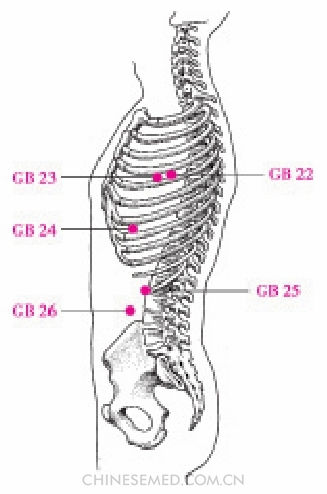
Location.method. With the patient seated or lying on one side, the point is at the junction of the upper 1/4 and lower 3/4 of a line connecting the midpoint of the axillary cavity and the 11th rib; this distance is taken as 12 cun.
Actions. Rectify qi and invigorate blood, unblock channels and relieve pain.
Indications. Chest tightness, hypochondrial pain, swelling of the axilla, pain and inability to raise the arm.
Manipulation. Acupuncture: Needle obliquely 0.5~ 0.8 cun. Local soreness and distention can spread to the chest and hypochondrium. Moxibustion: Use 3~5 cones of cone moxibustion, or use a moxa stick for 5~10 minutes.
Precaution. To prevent injury to the parietal pleura and lung, do not penetrate the thoracic cavity. Insert the needle along the long axis of the fourth rib, not perpendicularly.
Annotation. The point appeared in The Spiritual Pivot-Channels (Líng Shū-Jīng Mài, 灵枢·经脉). Yuān means abyss; yè means axilla. This point is 3 cun inferior to the axilla at its deepest region, so it was named yuān yè, axilla abyss.
GB 23 (Zhé Jīn, 辄筋)
Intersecting point of the foot shaoyang and foot taiyang channels
Location. The lateral thorax at the fourth intercostal space, 1 cun anterior to the midaxillary line (Pic. 3-77).
Actions. Direct counterflow downward, relieve panting, rectify qi, and invigorate blood.
Indications. Chest and hypochondrial pain, cough, asthma, vomiting, acid regurgitation, swollen axilla.
Manipulation. Acupuncture: Needle obliquely 0.5~0.8 cun. Local soreness and distention can spread to the chest and hypochondrium. Moxibustion: Use 3~5 cones of cone moxibustion, or use a moxa stick for 5~10 minutes.
Precautions. See GB 22 (yuān yè).
Annotation. The point appeared in The Systematic Classic of Acupuncture and Moxibustion (ZhēnJiŭ Jiă Yĭ Jīng, 针灸甲乙经). Zhé means curved sides of a carriage, which resemble the curvature of ribs. Jīn means sinews. Because the point is in the sinews of the fourth intercostal space, it is called zhé jīn, fank sinews.
GB 24 (Rì Yuè, 日月)
Front-mu point of gallbladder; intersecting point of foot shaoyang and foot taiyin channels
Location. The anterior thorax in the seventh intercostal space, 4 cun lateral to the anterior median line (Pic. 3-77).
Location.method. The point is inferior to the center of the nipple, one rib inferior to LV 14 (qīmén). In females, the point is at the intersection of the midclavicular line and the seventh intercostal space.
Actions. Direct counterflow downward and promote gallbladder function, and regulate the stomach and intestines.
Indications. Vomiting, hiccup, acid regurgitation, bitter taste with excessive saliva, jaundice, chest tightness, hypochondrial pain.
Manipulation. Acupuncture: Needle obliquely 0.5~0.8 cun. Local soreness and distention might spread to the chest and hypochondrium. Moxibustion: Use 3~5 cones of cone moxibustion, or use a moxa stick for 10~20 minutes.
Precautions. See GB 22 (yuān yè).
Annotation. The point appeared in The Pulse Classic (Mài Jīng, 脉经) and is the front-mu point of the gallbladder. The gallbladder is a judge and governs decision making, which is controlled by the lunar and solar cycles. Thus the point is called rì yuè, sun and moon.
GB 25 (Jīng Mén, 京门)
Front-mu point of kidney
Location. On the lateral abdomen inferior to the free extremity of the 12th rib (Pic. 3-77).
Location.method. With the patient lying on one side, shoulder fexed, locate the free extremity of the 12th rib by palpating below the inferior border of the costal arch posterior to the posterior axillary line.
Actions. Promote urination and relieve strangury, warm and supplement kidney yang.
Indications. Abdominal distension, borborygmus, diarrhea; difficulty urinating, edema; hypochondrial pain.
Manipulation. Acupuncture: Needle obliquely 0.5~1.0 cun. Local soreness and distention might spread to the lower back. Moxibustion: Use 5~9 cones of cone moxibustion, or use a moxa stick for 10~20 minutes.
Precautions. When inserting the needle, note direction, depth, and angle to avoid penetrating the abdominal cavity and injuring the kidney.
Annotation. The point appeared in The Pulse Classic (Mài Jīng, 脉经). Jīng means capital, which denotes importance. Mén means gate. This point, the front-mu point of the kidney, is where kidney channel qi gathers. As the main point for supplementing the kidney and promoting urination to treat water metabolism disorders, it is called jīng mén, capital gate.
GB 26 (Dài Mài, 带脉)
Intersecting point of the foot shaoyang channel and the dai mai
Location. On the lateral abdomen below the free extremity of the 11th rib and level with the center of the umbilicus (Pic. 3-77).
Location.method. Locate the tenth rib and find the free extremity of the 11th rib, which is situated immediately below the inferior border of the costal arch.
Actions. Clear heat and drain dampness, regulate menstruation, and arrest leukorrhea.
Indications. Irregular menstruation, morbid leukorrhea, amenorrhea, dysmenorrhea, infertility; hernia, lumbar pain, hypochondrial pain radiating to the back.
Manipulation. Acupuncture: Needle obliquely 0.5~1.0 cun. Local soreness and distention might spread to the lateral side of the waist. Moxibustion: Use a moxa stick for 10~20 minutes.
Precautions. 1. Insert the needle in accordance with the thickness of the abdominal wall. Do not insert too deeply. 2. To prevent penetrating the intestinal tract, do not thrust or lift the needle quickly or forcefully.
Annotation. The point appeared in The Spiritual Pivot-Mania (Líng Shū-Diān Kuáng, 灵枢·癫狂) and is the intersecting point of the foot shaoyang channel and the dai mai. Dài means belt. Dai mai qi passes through the point, which is called dài mài, dài channel.
GB 27 (Wŭ Shū, 五枢)
Intersecting point of the foot shaoyang channel and the dai mai
Location. On the lower abdomen, 3 cun inferior to the center of the umbilicus, medial to the anterior superior iliac spine (Pic. 3-78, Pic. 3-79).

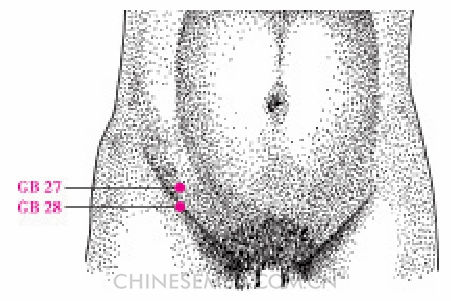
Actions. Regulate menstruation and leukorrhea, regulate the lower jiao, and unblock the bowels.
Indications. Irregular menstruation, morbid leukorrhea, amenorrhea, dysmenorrhea, infertility, lumbar and hip pain, lower abdominal pain, hernia.
Manipulation. Acupuncture: Needle perpendicularly 1.0~1.5 cun. Local soreness and distention might spread to the inguinal region. Moxibustion: Use 3~5 cones of cone moxibustion, or use warming needle moxibustion for 20 minutes, or use a moxa stick for 10~20 minutes.
Precautions. See GB 26 (dài mài).
Annotation. The point appeared in The Systematic Classic of Acupuncture and Moxibustion (Zhēn Jiŭ Jiă Yĭ Jīng, 针灸甲乙经). Wǔ means fve, a median number. Wǔ shū means center pivot. This point is 3 cun below GB 26 (dài mài) at the vertical midpoint of the body on the pivot of the hip joint. Therefore it is called wǔ shū, center pivot.
GB 28 (Wéi Dào, 维道)
Intersecting point of the foot shaoyang channel and dai mai
Location. On the lower abdomen 0.5 cun medioinferior to the anterior superior iliac spine (Pic. 3-78, Pic. 3-79).
Location.method. With the patient lying on one side, locate GB 27 (wǔ shū). GB 28 is 0.5 cun medioinferior to GB 27.
Actions. Regulate chong mai and ren mai, and regulate the lower jiao.
Indications. Irregular menstruation, morbid leukorrhea, amenorrhea, dysmenorrhea, infertility, lumbar and hip pain, lower abdominal pain, hernia.
Manipulation. Acupuncture: Needle obliquely 1.0~2.5 cun. Treat uterine prolapse by needling deeply at the round ligament of the uterus. Local soreness and distention might spread to the lower abdomen and external genitalia. Moxibustion: Use 3~5 cones of cone moxibustion, use warming needle moxibustion for 20 minutes, or use a moxa stick for 10~20 minutes.
Precautions. See GB 26 (dài mài).
Annotation. The point appeared in The Systematic Classic of Acupuncture and Moxibustion (ZhēnJiŭ Jiă Yĭ Jīng, 针灸甲乙经). Wéi means maintain. Dào means path. This point is the intersecting point of the foot shaoyang channel and dai mai and helps to maintain connections among channels. Therefore it is called wéi dào, linking path.
GB 29 (Jū Liáo, 居髎)
Intersecting point of the foot shaoyang, yangqiao, and yangwei mai
Location. On the buttocks at the midpoint of a line connecting the anterior superior iliac spine and the prominence of the greater trochanter (Pic. 3-78).
Actions. Relax the tendons and activate collaterals, and strengthen the lower back and legs.
Indications. Lumbar and leg pain, weakness or paralysis of the lower limbs, hernia.
Manipulation. Acupuncture: 1. Needle perpendicularly or obliquely 1.5~3.0 cun. Local soreness and distention might spread to the hip and ventrolateral region. 2. Many needling methods, including triple, central-square, valley union, lateral, successive trigger, and short needling, may be used to treat hip joint disorders. Moxibustion: Use 5~7 cones of cone moxibustion, or use warming needle for 20 minutes, or use a moxa stick for 10~20 minutes.
Annotation. The point appeared in The Systematic Classic of Acupuncture and Moxibustion (ZhēnJiŭ Jiă Yĭ Jīng, 针灸甲乙经). Jū means residence. Liáo means interosseous space. Because this point is in the interosseous space, it is called jū liáo, interosseous space residence.
GB 30 (Huán Tiào, 环跳)
Intersecting point of the foot shaoyang and foot taiyang channels
Location. On the buttocks at the junction of the lateral 1/3 and medial 2/3 of a line connecting the prominence of the greater trochanter with the sacral hiatus (Pic. 3-78, Pic. 3-80).
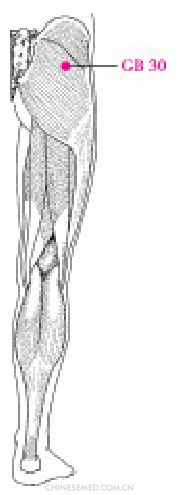
Location.method. With the patient lying on one side with the bottom leg extended and the upper thigh flexed, place the transverse crease of the little finger joint on the greater trochanter and point the thumb towards the spine. The point is at the tip of the thumb. Alternatively, with the patient prone, fnd the point in the depression posterior to the prominence of the greater trochanter at the junction of the lateral 1/3 and medial 2/3 of the line connecting the prominence of the greater trochanter and the sacral hiatus.
Actions. Expel wind-dampness, and strengthen the lower back and legs.
Indications. Lumbar and leg pain, atrophy or paralysis of the lower limbs, hemiplegia.
Manipulation. Acupuncture: 1. Needle 2.0~3.0 cun with the needle tip pointing slightly downward. Local soreness and distention will be felt and electric-like sensations might radiate to the lower limbs. This method treats sciatica and disorders of the lower limbs. 2. Needle obliquely 2.0~3.0 cun toward the genitals and lower abdomen. Local numbness and distention can reach the genitals to treat disorders of the genitals and lower abdomen. 3. Needle perpendicularly 2.0~2.5 cun toward the hip joint. Local soreness and distention should be felt. This method can treat disorders of the hip joint. 4. Many needling methods may be used, including triple, central-square, valley union, successive trigger, and short needling. Moxibustion: Use 5~7 cones of cone moxibustion, or use warming needle moxibustion for 20 minutes, or use a moxa stick for 10~20 minutes.
Precautions. Deep insertion might puncture the sciatic nerve.
Annotation. This point appeared in The Systematic Classic of Acupuncture and Moxibustion (Zhēn Jiŭ Jiă Yĭ Jīng, 针灸甲乙经). Huán means curve; tiào means jump. This point is at the hip joint. With the patient lying on one side and the hip and knee fexed into the shape of the number 4 as if the patient is in a jumping position, a curve is formed; hence the name huán tiào, jumping curve.
Modern clinical observation and research. In a case study on piriform muscle syndrome, GB 30 and local ashi points were needled every other day with 3-cun-long needles until the patient felt the needle sensation radiating to the lower limbs. Three to fve cones of moxa were applied at each point after the needles were removed; fve treatments constituted a course. Of 75 patients, 47 recovered (62.7%), 22 had significant pain reduction (29.3%).1
GB 31 (Fēng Shì, 风市)
Location. The lateral aspect of the thigh in the depression posterior to the iliotibial band where the tip of the middle fnger rests when one stands with arms extended downward (Pic. 3-81).
Location.method. With the patient upright, hands by the sides, the point is at the tip of the middle fnger. With the patient on one side, the point is on the lateral femoral midline between the ventrolateral muscle and biceps femoris, 7 cun superior to the popliteal crease (Pic. 3-82).
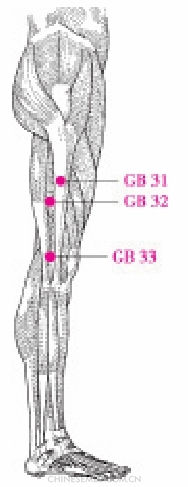

Actions. Expel wind-dampness, regulate blood and qi, and unblock collaterals.
Indications. Atrophy or paralysis of the lower limbs, beriberi, pruritus.
Manipulation. Acupuncture: Needle perpendicularly 1.5~2.5 cun. Local soreness and distention might radiate to the lower limbs. To treat ventrolateral soft tissue diseases, many needling methods, including triple, central-square, valley union, straight, and side needling, may be used. Moxibustion: Use 3~5 cones of cone moxibustion, or use warming needle moxibustion for 20 minutes, or use a moxa stick for 10~20 minutes.
Annotation. The point appeared in EmergencyFormulas to Keep Up One’s Sleeve (ZhŏuHòu Bèi Jí Fāng, 肘后备急方). Shì means market or gathering. This important point can treat disorders caused by pathogenic wind, so it is called fēng shì, wind market.
GB 32 (Zhōng Dú, 中渎)
Location. On the lateral aspect of the thigh posterior to the iliotibial band, 7 cun superior to the popliteal crease (Pic. 3-81).
1 Wang HB. Clinical observation of 75 cases of piriform muscle syndrome treated by acupuncture针灸治疗梨状肌综合征75例. Journal of Clinical Acupuncture and Moxibustion. 2005; 21(12): 16.
Location.method. With the patient lying on one side, the point is 5 cun superior to the popliteal crease on the lateral femoral midline.
Actions. Unblock the channels and quicken collaterals, scatter wind and dissipate cold.
Indications. Atrophy or paralysis of the lower limbs, hemiplegia.
Manipulation. Acupuncture: Needle perpendicularly 1.0~2.0 cun. Local soreness and distention might radiate to the lower limbs. Many needling methods may be used, including triple, centralsquare, straight, and side needling. Moxibustion: Use 3~5 cones of cone moxibustion, or use warming needle moxibustion for 20 minutes, or use a moxa stick for 10~20 minutes.
Annotation. This point appeared in The Systematic Classic of Acupuncture and Moxibustion (Zhēn Jiŭ Jiă Yĭ Jīng, 针灸甲乙经). Dú means ditch. The point is in the depression between the muscles on the lateral femoral midline, which is like a ditch through which channel qi must pass; hence the name zhōng dú, middle ditch.
GB 33 (Xī Yáng Guān, 膝阳关)
Location. On the lateral aspect of the knee in the depression between the biceps femoris tendon and the iliotibial band, posterior and proximal to the lateral epicondyle of the femur (Pic. 3-81, Pic. 3-83).
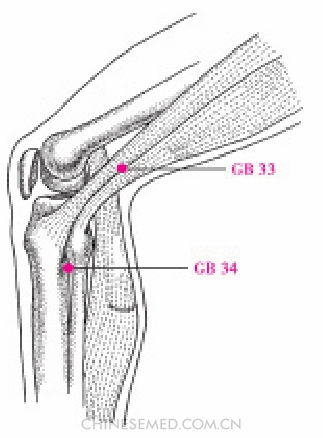
Actions. Relax sinews, quicken collaterals, ease joint movement, and resolve dampness.
Indications. Knee swelling, pain, and spasm; lower leg numbness.
Manipulation. Acupuncture: Needle perpendicularly 1.0~2.0 cun. Local soreness and distention might spread to the knee and lateral side of the thigh. Moxibustion: Use 3~5 cones of cone moxibustion, or use warming needle moxibustion for 20 minutes, or use a moxa stick for 10~20 minutes.
Annotation. The point appeared in The Systematic Classicof Acupuncture and Moxibustion (Zhēn Jiŭ Jiă Yĭ Jīng, 针灸甲乙经). The lateral part belongs to yang, and guān means joint. The point is on the side of the knee, so is called xī yángguān, yang knee joint.
GB 34 (Yáng Líng Quán, 阳陵泉)
He-sea point; lower he-sea point of the gallbladder; influential point of the sinews
Location. On the fbular aspect of the leg in the depression anterior and distal to the head of the fbula (Pic. 3-83).
Actions. Clear heat and extinguish wind, relieve edema and pain.
Indications. Headache, tinnitus, deafiness, eye pain; liver and gallbladder disorders such as hypochondrial pain, jaundice, bitter taste in the mouth, vomiting, acid refux; knee swelling and pain, atrophy or paralysis of the legs; infantile convulsions.
Manipulation. Acupuncture: 1. Needle perpendicularly 1.0~3.0 cun. Deep needling can reach SP 9 (yīn líng quán). Local soreness and distention will be felt, and numbness and electric-like sensations might radiate downward. 2. Needle obliquely upward 0.5~0.8 cun. Local soreness and distention will be felt. Moxibustion: Use 3~5 cones of cone moxibustion, or use warming needle moxibustion for 20 minutes, or use a moxa stick for 5~10 minutes.
Precautions. If insertion is difficult, change the direction of the needle to avoid injuring blood vessels and nerves. Scarring moxibustion is forbidden.
Annotation. This point appeared in The Spiritual Pivot (Líng Shū, 灵枢). The lateral part belongs to yang; líng means a high place, and quán means depression. Therefore the point is called yáng líng quán, yang mound spring.
Modern clinical observation and research. In an RCT on self-help treatment for soldiers with myofascial back pain syndrome (MPS), 30 patients were treated with suspended moxa at GB 34 for 15 minutes and a moxibustion massage device was used at the pain location; 28 received an herbal plaster, goupi gao. Treatment was given once a day for 5 days in both groups. The effective rate was 96.7% (29/30) for the moxibustion and 35.7% (10/28) for the plaster; the moxibustion was significantly better (P<0.01) and more cost effective.1
In a 3-arm, single-blind, RCT comparing acupuncture plus etoricoxib, sham acupuncture plus etoricoxib, and etoricoxib alone for chronic knee arthritis pain, treatment was given twice a week for eight weeks. The acupuncture, ST 36 (zú sān lĭ), SP 9 (yīn líng quán), SP 10 (xuè hăi), GB 34 (yánglíng quán), hè dĭng (EX-LE 2), and xī yăn (EX-LE 5) and the distal points LI 4 (hé gŭ), KI 3 (tài xī), ST 40 (fēng lóng), and SP 6 (sān yīn jiāo), with EA at ST 36-SP 9 and GB 34-SP 10 for 20 minutes starting at week three, produced statistically significant improvement in primary and secondary outcome measures compared to the other groups.2
GB 35 (Yáng Jiāo, 阳交)
Xi-cleft point of the yangwei mai
Location. On the leg posterior to the fbula, 7 cun above the prominence of the lateral malleolus (Pic. 3-84).
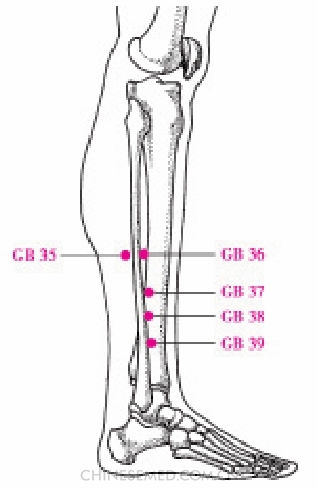
Location.method. The point is posterior to GB 36 (wàiqiū) and 1 cun distal to the midpoint of a line connecting the prominence of the lateral malleolus to the lateral end of the popliteal crease.
Actions. Relax sinews, quicken collaterals, and calm the mind.
Indications. Mental disorders such as depression and mania, epilepsy, distending pain in chest and hypochondrium, lower limb atrophy or paralysis.
Manipulation. Acupuncture: Needle perpendicularly 1.0~1.5 cun. Local soreness and distention might radiate to the foot. Moxibustion: Use 3~5 cones, warming needle moxibustion, or a moxa stick for 5~10 minutes.
1 Guan L, Zou Y, Yang YL. Observation on therapeutic effect of myofascial pain syndrome of the back in the military soldiers treated with moxibustion艾灸治疗战士背肌筋膜疼痛综合征疗效观察. Chinese Acupuncture & Moxibustion. 2012; 32(7): 597-601.
2 Mavrommatis CI, Argyra E, Vadalouka A, Vasilakos DG. Acupuncture as an adjunctive therapy to pharmacological treatment in patients with chronic pain due to osteoarthritis of the knee: a 3-armed, randomized, placebo-controlled trial. Pain. 2012; 153(8): 1720-6.
Annotation. The point appeared in The Systematic Classicof Acupuncture and Moxibustion (Zhēn Jiŭ Jiă Yĭ Jīng, 针灸甲乙经). The lateral part belongs to yang. Jiāo means intersection. This is the intersecting point of the foot shaoyang and the yangwei channels, so it is called yáng jiāo, yang intersection.
GB 36 (Wài Qiū, 外丘)
Xi-cleft point of the gallbladder
Location. On the leg anterior to the fbula, 7 cun above the prominence of the lateral malleolus (Pic. 3-84).
Location.method. The point is anterior to GB 35 (yáng jiāo) and 1 cun distal to the midpoint of a line connecting the tip the lateral malleolus to the lateral end of the popliteal crease.
Actions. Soothe the liver and rectify qi, unblock channels and quicken collaterals.
Indications. Depression and mania, epilepsy, distending pain in the chest and hypochondrium, lower limb atrophy or paralysis.
Manipulation. Acupuncture: Needle perpendicularly 0.5~0.8 cun. Local soreness and distention might radiate to the foot. Moxibustion: Use 3~5 cones of cone moxibustion, or use warming needle moxibustion for 20 minutes, or use a moxa stick for 5~10 minutes.
Annotation. The point appeared in The Systematic Classic of Acupuncture and Moxibustion (ZhēnJiŭ Jiă Yĭ Jīng, 针灸甲乙经). It is at the lateral aspect of the lower leg where the muscle is raised like a mound, so it is called wài qiū, outer mound.
GB 37 (Guāng Míng, 光明)
Luo-connecting point
Location. On the leg anterior to the fibula, 5 cun proximal to the prominence of the lateral malleolus (Pic. 3-84).
Actions. Unblock channels and quicken collaterals, soothe the liver and brighten the eyes.
Indications. Eye pain, night blindness, blurred vision; disorders on the running course of the channel such as swollen cheek, distending pain in the breast, insufficient lactation, atrophy or paralysis of the lower limbs, numb and cold feet and hands.
Manipulation. Acupuncture: Needle perpendicularly 1.0~1.2 cun. Local soreness and distention might radiate to the knee joint or to the lateral aspect of the dorsum of the foot. Moxibustion: Use 3~5 cones of cone moxibustion, or use warming needle moxibustion for 20 minutes, or use a moxa stick for 5~10 minutes.
Precautions. Avoid injuring the anterior tibial artery and vein when needling deeply.
Annotation. The point appeared in The Spiritual Pivot-Channels (Líng Shū-Jīng Mài, 灵枢·经脉). This point is the luo-connecting point of foot shaoyang and connects to the foot jueyin liver channel. The liver opens to the eyes. Because the main function of this point is to brighten the eyes and treat eye disorders, it is called guāng míng, brighten vision.
Modern clinical observation and research. Patients with double vision after stroke were treated with acupuncture at GB 37 (guāng míng), GB 20 (fēng chí), and SP 6 (sān yīn jiāo) every day for 15 days; 31 recovered and 1 received no benefit.1
GB 38 (Yáng Fǔ, 阳辅)
Jing-river point
Location. On the leg anterior to the fibula, 4 cun proximal to the prominence of the lateral malleolus (Pic. 3-84).
Actions. Scatter wind, clear heat, relax sinews, and quicken collaterals.
1 Li P. Treatment of 32 cases of double vision after stroke with acupuncture针刺治疗中风后复视症32例. Shanghai Journal of Acupuncture and Moxibustion. 2005; 24(1): 24.
Indications. Migraine; pain at the outer canthus; pain in chest, hypochondrium, and the lateral aspect of the limbs; scrofula; lower limb atrophy or paralysis.
Manipulation. Acupuncture: Needle perpendicularly 1.0~1.5 cun. Local soreness and distention might radiate downward. Moxibustion: Use 3~5 cones of cone moxibustion, or use warming needle moxibustion for 20 minutes, or use a moxa stick for 5~10 minutes.
Precautions. Avoid injuring the anterior tibial artery and vein when needling deeply.
Annotation. The point appeared in The Spiritual Pivot-Fundamental Points (Líng Shū-Běn Shū,灵枢·本输). The lateral part belongs to yang; fǔ means fbula. The point is at the anterior border of the fbula and so is called yáng fǔ, yang auxiliary.
GB 39 (Xuán Zhōng, 悬钟)
influential point of the marrow
Location. On the leg anterior to the fibula, 3 cun proximal to the prominence of the lateral malleolus (Pic. 3-84).
Location.method. With the patient recumbent or sitting foot downward, palpate upward from the tip of the lateral malleolus to the fibula; the point is in the depression between the posterior border of the fbula and the peroneus longus and brevis tendon.
Actions. Relax sinews, quicken collaterals, supplement blood, and boost marrow.
Indications. Neck stiffiness and pain, distending pain in chest and hypochondrium, lower limb atrophy or paralysis, heel pain, bone-attached carbuncle, dementia, stroke.
Manipulation. Acupuncture: Puncture perpendicularly 1.0~2.0 cun. Local soreness and distention might spread to the sole. Moxibustion: Use 3~5 cones of cone moxibustion, or use warming needle moxibustion for 20 minutes, or use a moxa stick for 10~20 minutes. Scarring moxibustion may be used.
Precautions. Avoid injuring the artery and vein.
Annotation. The point appeared in The Systematic Classic of Acupuncture and Moxibustion (ZhēnJiŭ Jiă Yĭ Jīng, 针灸甲乙经). Xuán means suspend; zhōng means bell. Because the point is above the lateral malleolus, which looks as if it is suspended, it is called xuán zhōng, suspended bell.
GB 40 (Qiū Xū, 丘墟)
Yuan-source point of the gallbladder
Location. The anterolateral aspect of the ankle in the depression lateral to the extensor digitorum longus tendon and anterior and distal to the lateral malleolus (Pic. 3-85).
Actions. Clear summerheat, discharge heat, cool blood, resolve toxins, awaken the brain, calm the mind, relax sinews, and quicken collaterals.
Indications. Migraine; swollen axilla; neck, chest and hypochondrial pain; swelling and pain in the lateral malleolus; blurred vision; atrophy or paralysis of the foot; beriberi.
Manipulation. Acupuncture: 1. Needle perpendicularly 0.5~1.0 cun. Local soreness and distention might radiate to the foot. 2. Needle obliquely and laterally 0.8~1.0 cun to reach BL 62 (shēn mài). Local soreness and distention might spread to the ankle. Moxibustion: Use 5~7 cones of cone moxibustion, or use warming needle moxibustion for 20 minutes, or use a moxa stick for 10~20 minutes.
Precautions. Scarring moxibustion is forbidden.
Annotation. The point appeared in The Spiritual Pivot-Fundamental Points (Líng Shū-Běn Shū,灵枢·本输). Qiū means mound or hill. Xū means bigger mound. Because the point is anterior and inferior to the lateral malleolus, a big mound, it is called qiū xū, outer mound.
Modern clinical observation and research. In a multicenter RCT on EA for migraine, GB 40 was used in treatment group, and ST 25 (tiān shū) was used as control. Both groups were treated for six months. At two of the three treatment centers, effects were significantly better at three months in the treatment group, not obviously changed in the third. At six months, effects were significantly better in all three centers.
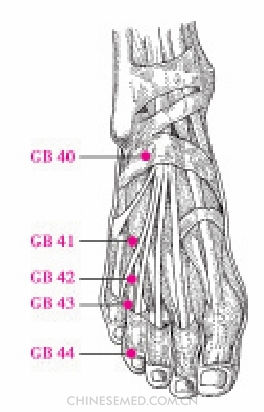
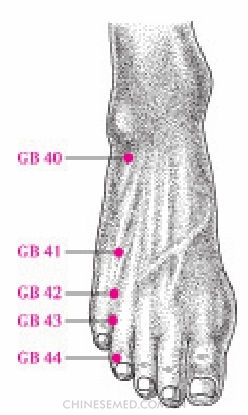
GB 41 (Zú Lín Qì, 足临泣)
Shu-stream point; confuence point of the dai mai
Location. On the dorsum of the foot distal to the junction of the bases of the fourth and fifth metatarsal bones in the depression lateral to the fifth extensor digitorum longus tendon (Pic. 3-85).
Actions. Soothe the liver, resolve constraint, extinguish wind, and discharge heat.
Indications. Migraine, dizziness, eye pain, mastitis, difficulty breathing, swollen axilla, hypochondrial pain; swelling and pain in the dorsum of the foot, knee, and ankle.
Manipulation. Acupuncture: 1. Needle perpendicularly 0.5~0.8 cun. Local soreness and distention might radiate to the tips of the toes. 2. Bleed with a three-edged needle. Moxibustion: Use 3~5 cones of cone moxibustion, or use warming needle moxibustion for 20 minutes, or use a moxa stick for 5~10 minutes.
Precautions. Scarring moxibustion is prohibited.
Annotation. This point appeared in The Spiritual Pivot-Fundamental Points (Líng Shū-Běn Shū,灵枢-本输). It was called lín qì to differentiate it from tóu lín qì, GB 15. It was first called zú lín qì in the Comprehensive Recording of Divine Assistance (Shèng Jì Zŏng Lù, 圣济总录). Lín means governance. Qì means tears, the fuid of the liver, which opens to the eye; gallbladder channel qi reaches the eyes and can treat eye disorders. This is the shu-stream point of the foot shaoyang; in the fve phases it belongs to wood. Because it is located on the foot instead of head (where tóu lín qì, islocated), it is called zú lín qì, foot governor of tears.
1 Jia CS, Ma XS, Shi J,Wang YM, Li YF, et al. Clinical report on multi-center randomized controlled trial of treatment of migraine by electro-acupuncture at GB 40 (qiū xū) 电针丘墟穴治疗偏头痛多中心随机对照研究.World Journal of Acupuncture-Moxibustion. 2008; 18(1): 1-11.
GB 42 (Dì Wǔ Huì, 地五会)
Location. On the dorsum of the foot between the fourth and fifth metatarsal bones in the depression proximal to the fourth metatarsophalangeal joint (Pic. 3-85).
Actions. Soothe the liver and promote gallbladder function, unblock channels and quicken collaterals.
Indications. Headache; eye redness, swelling, and pain; tinnitus; deafiness; mastitis; difficulty in breathing; swelling of the axilla; hypochondrial pain; swelling and pain in the dorsum of foot, knee, and ankle.
Manipulation. Acupuncture: Needle perpendicularly 0.5~0.8 cun. Local soreness and distention will be felt. Moxibustion: Use 3~5 cones of cone moxibustion, or use warming needle moxibustion for 20 minutes, or use a moxa stick for 5~10 minutes.
Precautions. See GB 41 (zú lín qì).
Annotation. The point appeared in The Systematic Classic of Acupuncture and Moxibustion (ZhēnJiŭ Jiă Yĭ Jīng, 针灸甲乙经). Dì means square. Wǔ is a median number. Huì means convergence. There are five points on the foot in the gallbladder channel; this point is in the middle at the convergence of the foot shaoyang channel qi. Thus it is called dì wǔ huì, earth fvefold convergence.
GB 43 (Xiá Xī, 侠溪)
Ying-spring point
Location. On the dorsum of the foot between the fourth and fifth toes, proximal to the margin of the web at the border between the red and white fesh (Pic. 3-85).
Actions. Clear heat and extinguish wind, reduce swelling and ease pain.
Indications. Headache, tinnitus, deafiness, eye pain, dizziness, swollen cheek, fever and febrile diseases, distending pain in chest and hypochondrium, cough, asthma; swelling and pain in the dorsum of foot, knee, and thigh.
Manipulation. Acupuncture: Needle perpendicularly 0.5~0.8 cun. Local soreness and distention will be felt. Moxibustion: Use 3~5 cones of cone moxibustion, or use warming needle moxibustion for 20 minutes, or use a moxa stick for 5~10 minutes.
Precautions. See GB 41 (zú lín qì).
Annotation. The point appeared in The Spiritual Pivot-Fundamental Points (Líng Shū-Běn Shū,灵枢·本输). Xiá means clamp. Xī means stream. This point is between the fourth and little toes; thus it is called xiá xī, clamped stream.
GB 44 (Zú Qiào Yīn, 足窍阴)
Jing-well point
Location. On the fourth toe lateral to the distal phalanx, 0.1 cun proximal to the corner of the toenail at the intersection of a vertical line along the lateral aspect of the nail and a horizontal line along its base (Pic. 3-85).
Location.method. The point is at the junction of the lines drawn along the lateral border and base of the nail of the fourth toe.
Actions. Unblock channels and quicken collaterals, and clear heat to resolve constraint.
Indications. Migraine; tinnitus; deafiness; eye redness, swelling, and pain; pharyngitis; chest and hypochondrial pain; swelling and pain in the dorsum of the foot.
Manipulation. Acupuncture: Needle shallowly 0.1~0.2 cun; local soreness and distention will be felt. Alternatively, prick with a three-edged needle to induce bleeding. Moxibustion: Use 3~5 cones of cone moxibustion, or use a moxa stick for 5~10 minutes.
Precautions. See GB 41 (zú lín qì).
Annotation. The point appeared in The Spiritual Pivot-Fundamental Points (Líng Shū-Běn Shū,灵枢·本输). Its original name was qiào yīn to differentiate it from GB 11 (tóu qiào yīn). It was first called zú qiào yīn in the Comprehensive Recording of Divine Assistance (Shèng Jì Zŏng Lù, 圣济总录). Qiào means orifce; yīn refers to foot jueyin. This point is the jing-well point of the shaoyang channel; it associates with the foot jueyin liver channel, so it is called zú qiào yīn, foot yin opening.

